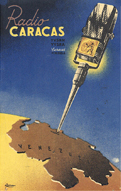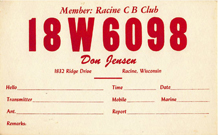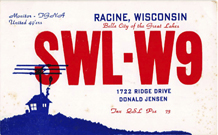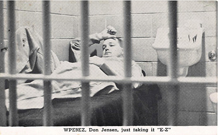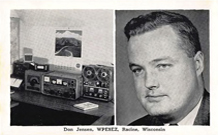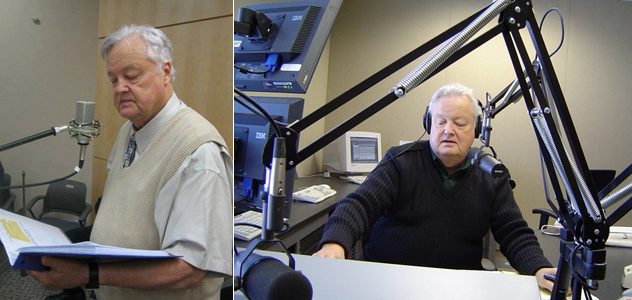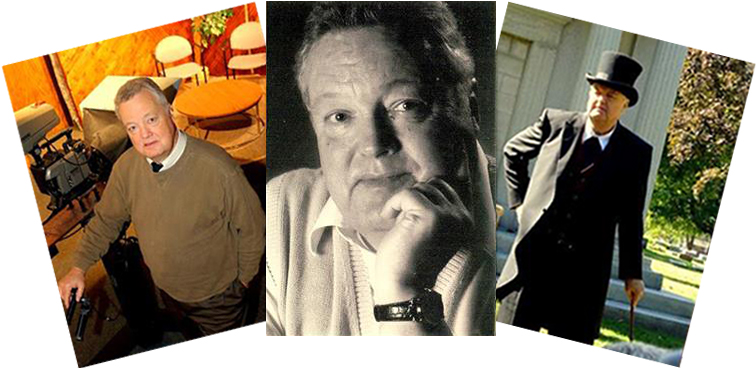
|
Back to OTSW
Select QSLs from the collection of Don Jensen Austria - Austrian Army Station (1971) Bolivia - R. Emisora 2 de Febrero (1979) Brazil - R Voz Missionaria (2013) China - Beihai Weather Station (1983) Clandestine - Liberty (Falklands) (1983) Clandestine - R. Libertad (Cuba) (1968) Clandestine - V. of the Pathet Lao (1971) Colombia - Ecos de Pto. Martinez (1973) Colombia - La Voz de la Selva (1977) Costa Rica - R. Excelsior (1953) Ecuador - La Voz de Saquisili (1976) Ecuador - La Voz del Triunfo (1979) Ecuador - R. El Buen Pastor (2013) Honduras - R. Juticalpa (1978) Indonesia - RKPD Nganjuk (1979) Indonesia - RPD Sidoarjo (1974) Indonesia - RSPD Magelang (1986) Korea, South - Voice of Hope (1968) Norway - R. Norway, Tromso (1972) Paraguay - La Voz del Amambay (1978) Spain - R. Mediterraneo (1957) Venezuela - La Voz de El Tigre (1958) Venezuela - Ondas Panamericanas (1979) |
Although we mostly knew him as a resident of Kenosha, Don Jensen was born in Racine, Wisconsin on September 23, 1935, and he was living in Racine when he heard his first shortwave station. He went to Park High School and graduated from the University of Wisconsin in Madison, where he won both bachelors and masters degrees. After his return from two years in the Army he went to work as the first news director at Kenosha FM station WAXO. There he met his future wife, Arlene, whom he would marry in 1967. In 1963 Don joined the Kenosha News. Arlene would join him at the News later, and their “joint” careers in journalism were underway. His beat was the police and the courts.
Don often told the story about being introduced to shortwave in 1947 by his father, a sometimes shortwave listener, who had bought himself an all-band Midwest console. Don heard his first station, HCJB, on April 17, 1947. “My first ‘solo’ log,” he explained 40 years later in the Great Circle Shortwave Society bulletin, “came a few months later when on a summer afternoon this 11 year-old–like the Sorcerer’s Apprentice, not really knowing what he was doing but daring to fool around with Dad’s mysterious radio–blundered into HER5 from Switzerland on some forgotten 25 meter frequency. That catch was followed, thanks to a briefing on what verifications were and how to get them, by my first QSL some weeks later.” Soon he had his own receiver, a second-hand Hallicrafters three-tube S41G, the Skyrider Junior, which his father bought him for around $25. A couple of years later he graduated to an SX-71, which he purchased by combining a “loan” from his father with money he earned from his Saturday job as a stock boy. He was moderately active during his teenage years (during which Santa Claus brought him a longed-for RME DB22A preselector). He got most of his tips from Ken Boord’s monthly Radio News column until joining his first club, the United 49ers Radio Society, around 1951. Shortwaving was limited during his college years, 1954-58, when he had access to a receiver only on weekends at home, and during his military service, which lasted from October 1958 to October 1960. At one time Don had both a ham license (KN4ISC) and a CB call (18W6098). But these were diversions, for Don was first and foremost a shortwave broadcast DXer. He was always among the first–often the first–to hear and verify a new station. Wisconsin wasn’t the best location for DX either from the east or the west, but Don’s patience and persistence, his knowledge of when and where to listen, and what to listen for, and his top-of-the-line receivers–including, in their day, a Hammarlund HQ-180 and a Drake R7–made up the difference. His focus was always on Indonesia, the Indian subcontinent, and Latin America (particularly the Andean countries). Over his career he heard 255 radio countries, as measured by the country list of the North American Shortwave Association (NASWA). And he verified every one of them. Don did not consider the logging of a new station or a new country “complete” until he received the QSL. In October 1969, unhappy with the delay inherent in the usually-monthly cycle that most DX news traveled in the long-ago days before e-mail, Don started a newsletter which he called Número Uno. True to that name, he invited 25-30 of the top DXers to participate. Save for a few periods when he had co-editors, Don did everything himself, compiling members’ submissions into a two page mimeo and mailing it every week using the self-addressed stamped envelopes that members kept on file. Although its restricted membership sometimes led to cries of NU “elitism,” for serious DXers it was the place to be, and the source of much of the “breaking” shortwave news. But NU was a jealous mistress. Two pages sometimes became four, or even six. In 1989, after 20 years at the helm, Don retired from NU and passed the editorial baton to others. NU continued publication, first on paper and then electronically, until June 2001, when it was recreated as a Yahoogroup called DXplorer. Over the years, 119 DXers had participated in NU.
NU led to closer personal contacts among its members by way of the annual NU conventions, the first one held in 1973. In 1982 the conventions came under the joint sponsorship of NU and Fine Tuning, another DX newsletter, and in 1988 they began functioning independently. Today, 40 years after the first “NUvention,” they are still being held. High DX standards were important to Don, and in 1973 he authored a series of six articles for NASWA called “On to the Top,” which contained his thoughts on what made a good DXer. Experience, knowledge of the bands, and knowledge of propagation; regular tuning, and concentration on particular stations; caution in identifying stations; and care and thoroughness in writing reception reports–these were the essentials for which good equipment alone could not compensate. NASWA reprinted the series twice (1982-83, 1996). It was also included in Gerry L. Dexter’s book, Shortwave Radio Listening With the Experts (1986), and it is still a valid primer for the serious DXer. Don gave his thoughts about a number of issues in a 1984 interview with NASWA’s “Shortwave Broadcast Center” editor, John C. Herkimer. Don joined the North American Shortwave Association about two years after the club’s very humble beginnings in September 1961. It was an all-wave club with a rocky history when Don assumed a place on the board of directors in 1964. There was much competition from other clubs, and it was thought that specialization might be the road to the club’s success. It was shortwave broadcasting that interested the most members, and, at Don’s urging, a vote of the membership was held, recasting NASWA as a club covering shortwave broadcasting only, effective August 1966. Don became the overall shortwave editor, and for two years he prepared “Shortwave Broadcast Center,” a features column. Soon NASWA would become the premier club for SWBC enthusiasts, and Don would be an influential voice during much of its history. When he got back into DXing in the early 1960s Don found a club scene that was fractionated. There was a need for a number of activities that were beyond the reach of individual clubs alone–promoting the common good of DX enthusiasts, improving cooperation among the clubs, and doing outreach to the greater radio listening community. In 1964, at Don’s initiative, the Association of North American Radio Clubs was formed. “ANARC” was modeled after DX-Alliansen, an umbrella group of radio clubs in Sweden (a place where DX activity abounded). Don was the group’s first Executive Secretary, and served for two years. Twelve others would serve in that post, and ANARC would deal with numerous issues–frequency planning, non-verifying stations, liaison with equipment manufacturers, public relations, and many others–during its 40-year life. In 1966, ANARC awarded its first Man-of-the-Year Award to Don. In 1999, the top ANARC award was renamed the Don Jensen Distinguished Service Award. Competition in hearing stations and countries is a long tradition among shortwave listeners, and one of the most important and long lasting of Don’s contributions was the creation of a uniform method for counting shortwave countries heard and verified. The then-existing countries lists of various clubs and organizations had many defects: hams tended to count “every rock in the ocean”; countries were added and dropped based on political events; and little distinction was made between broadcast stations and others on shortwave, e.g. military and point-to-point. Don was a member of a small group of correspondents known as the DXplorers Radio Association, which had discussed these shortcomings and developed a list designed especially for shortwave broadcast DXing. In 1967 Don persuaded NASWA to adopt this list. Its basic philosophy, which balanced politics, geography and hobby traditions, was, and still is, “once a country, always a country.” The list encouraged competition, but did not penalize DXers for political changes that occurred before they started listening. Don became chairman of the NASWA Countries List Committee, which dealt with new countries and with questions that arose under the list. The Countries List Committee is still functioning today, largely the same way as when Don set it up decades ago. In 1989, Don described the countries list philosophy in an article in Proceedings. While many knew Don through his work with NASWA and ANARC, many more knew him by his writings in various popular magazines. From broadcasting’s early days, many radio and electronics magazines had columns devoted to shortwave listening. This was partly in recognition of the obvious role that electronic equipment played in the hobby, and partly in hopes that SWLs would get their “ham ticket” and become more involved in the technical side of radio. With his journalism background Don was a natural for this kind of authorship, and over the years his name would be associated with many magazines. One of the most popular was Elementary Electronics. Don was the magazine’s shortwave editor from 1967 to 1980, and wrote EE’s “DX Central Reporting” column, which continued to appear for a brief time in EE’s short-lived successor publication, Science & Electronics. S9, a magazine devoted mainly to citizens band radio, was published for 20 years starting in 1962. It carried some non-CB SWL news in the “DX Korner” column, which Don wrote from 1976 to 1979. Popular Electronics was the major news stand source of shortwave news from 1954 to 1970. It resumed coverage of shortwave from 1974 to 1982 with its “DX Listening” column. In 1983 the column, by-then written by Don, reappeared in a new Gernsback magazine called Special Projects, which became Hands on Electronics in 1984. Gernsback bought the Popular Electronics name, and in 1989 “Hands on” became the “new” Popular Electronics. Don’s column continued during all the changes. It moved to Electronics Now for the period July-December 1999, after which PE and Electronics Now were combined into Poptronics and shortwave coverage was dropped. Don took on other writing duties as well. He was Communications Editor for Communications World, the successor publication to Radio-TV Experimenter. CW was a 100-page compendium published twice a year from 1971 to 1977, then annually until 1981. The first half of each issue was usually an extensive primer, written by Don, covering all aspects of shortwave listening. “White’s Radio Log,” whose origins date back to 1924, appeared in Radio-TV Experimenter, and then Science & Electronics and Communications World, from 1958 to 1981, and during the latter part of the 1960s Don did much of the work on White’s. When White’s made a one-time reappearance as a standalone publication in 1985, Don authored an introductory essay on White’s, which he titled “The Legend and the Legacy.” The history of Passport to World Band Radio may well have been different had it not been for Don. The first issue was published in 1984, and the annual soon became one of the DX community’s two “must have” authorities on shortwave broadcasting (the World Radio TV Handbook was the other). Don was a Consulting Editor for Passport from 1984 to 1988. Thereafter, and until Passport’s final edition in 2009, he was recognized as Passport Founder Emeritus. The book’s creator and Editor-in-Chief, Larry Magne, describes Don’s role this way:
In addition to all of the above, Don was a prolific author of individual articles on various shortwave topics. Over the years they appeared in, among other places: FRENDX ("Radio In Lima, Peru," "Sketches Of South American Radio," and "Up The Lazy River To Puerto Martinez"); Science & Electronics; the Communications Handbook; Passport to World Band Radio ("Listening In: How Sweet It Is!" and "When Radio Is Forbidden"); Popular Communications (“The Mysterious Radio Euzkadi” and “The Life and Death of Radio Biafra”); and Radio-TV Experimenter. One of Don’s unique contributions to the shortwave community was his early work on radio history, in particular the clandestine radio operations of World War II and later. Don was an inveterate researcher, and as adept as DXers were in hearing and identifying weak shortwave signals, the DX community had little knowledge of the many stations that had made up shortwave broadcasting’s history. Don was one of the first to explore this area. For two years after he became editor of NASWA’s “Shortwave Broadcast Center” in 1966 he digested and serialized in the “Clandestine Corner” much of the content of his “History of Clandestine Radio Operations,” which he had prepared under the umbrella of the DXplorers. Three other early Jensen works on clandestine radio are Clandestine Radio Operations in the Cuban Revolutionary and Counter Revolutionary Movement: 1953-1965, Pt. I–Revolutionary (pro-Castro) Radio Activities, and Pt. II–Counter Revolutionary (anti-Castro) Radio Activities; and Radio Swan and Radio Americas, which he wrote in 1965. Occasionally Don’s voice was heard over the air. “Don Jensen’s Journal” was one of several segments featured in Radio Canada International’s weekly “SWL Digest” program in the mid- to late-80s. Don took a much lower profile in the DX community after turning over the reins of NU in 1989 (although he continued to write the “DX Listening” column for Popular Electronics for another decade). But he followed NU, even after it went electronic. In recent years, as Don embraced the “new technology,” he renewed his interest in shortwave. His many friends were happy to see him “back in action,” looking for stations he had missed, e-mailing on shortwave topics, enjoying DX nostalgia, rearranging his QSLs, etc. While shortwave had been his major hobby occupation for many years, his retirement years illustrate the variety of Don’s interests. One of his other hobbies, which he shared with Arlene, was doll collecting. He wrote many articles on the subject, as well as two books: Collector’s Guide to Horsman Dolls, 1865-1950 (2002), and Horsman Dolls–The Vinyl Era, 1950 to Present (2007). He and Arlene were active in national doll collecting circles and presented many programs at various local and national meetings. You can learn more about Don’s doll collecting in an online video. It is clear that the doll-collecting Don is the same as the radio-loving Don whom we knew for many years.
Don was also very much involved with the Kenosha Museum and the WGTD Radio Theater, where he directed and acted in radio dramas and even wrote scripts, and, as with his shortwave activities, helped others hone their skills. (To hear Don in action, go to the WGTD Radio Theater archive and search for “Don Jensen.”) With Don’s love of history it is no surprise that he was a member of the City of Kenosha Historic Preservation District (three times its chairman), and, for 25 years, on the board of the Kenosha County Historical Society. He was an expert on Kenosha County history, authoring a book on the subject (Kenosha Kaleidoscope–Images of the Past [1985]) and leading history tours and doing re-enactments. Don also knew his auto history, as can be seen in the YouTube video, “Automotive History in Kensoha, Wisconsin.” And as DXers who were interested in tracking down some old timers discovered, Don also knew genealogy and was very able at locating people and searching family trees. The DX world was stunned when it learned that Don had died, at home, unexpectedly, on May 23, 2013. The flood of comments from within the DX community captured the man.
Don was preceded in death by a brother, and by daughter Rhanda. He is survived by his wife Arlene, two sons, Erik and Steven, and six grandchildren. Arlene donated his QSLs to the Committee to Preserve Radio Verifications, and they are now part of the CPRV collection at the Library of American Broadcasting, University of Maryland, College Park.
Above photos used with permission of WGTD. |
